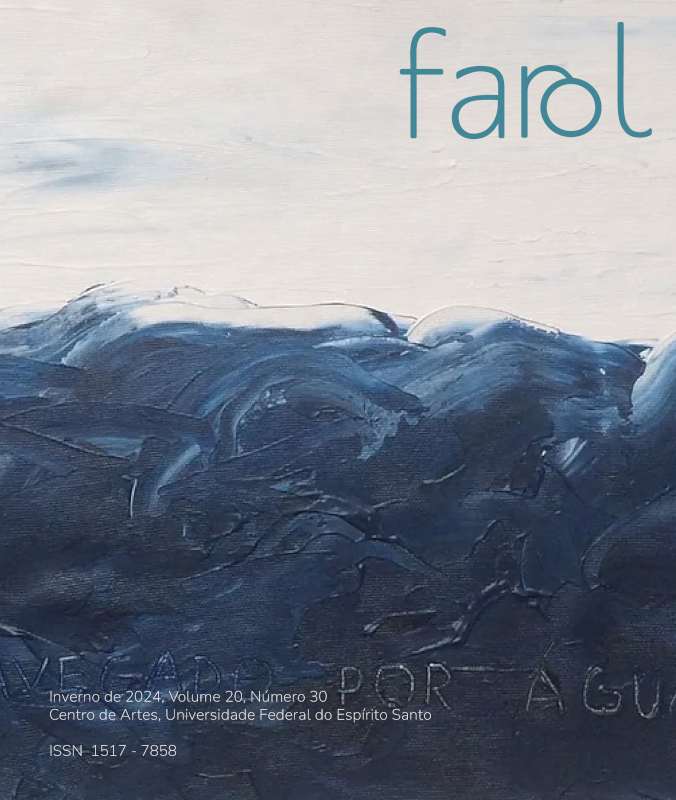Technologie et accessibilité
création du livre audio pour enfants « Je veux voir le vrai iemanjá »
DOI :
https://doi.org/10.47456/rf.v20i30.45001Mots-clés :
roteiro, peça radiofônica, audiodescrição, audiolivro, IemanjáRésumé
Le but de cet article est d'analyser le processus de transposition du conte pour enfants « Quero ver a Iemanjá de Verdade » dans un livre audio, qui fait partie du livre Minhas Histórias com Belinha. L'objectif est d'analyser le processus de création de deux scénarios basés sur la nouvelle susmentionnée : le premier est le scénario d'une pièce radiophonique pour un livre audio ; le second est un script de description audio d'illustrations de l'histoire, qui sera enregistré en complément de la pièce radiophonique. Pour la base théorico-critique de l'analyse, les documents suivants étaient pertinents : Comparato (2018) sur la construction de scénarios ; Street (2006), Sperber (1980) et Huwiler (2010) à propos d'une pièce radiophonique ; Bolter et Grusin (2000), Elleström (2010) sur les études sur les médias ; Hayles (2004), De Arzabal (2021) et de Gumbrecht (2004) sur la matérialité.
Références
ANASTÁCIO, Sílvia Maria Guerra. “Quero ver a Iemanjá de verdade”. In: Minhas histórias com Belinha. Salvador: Editora Dialética, 2024 (no prelo).
ARAÚJO, Vera Lúcia Santiago; MONTEIRO, Silvia Malena Modesto, 2024, no prelo). “Acessibilidade do vídeo Arte no Confinamento: Uma nova modalidade de audiodescrição”. In: Cultura, Acessibilidade e Pessoas com Deficiência. Rio de Janeiro: Editora da UFRJ, 2024, no prelo.
ARZABAL, Roberto Cruz. “Materialidade”. In:AKTORIES, Susana Gonzáles; ARZABAL, Roberto Cruz; WALLS, Marisol García (orgs). Vocabulário crítico para los estúdios intermediales. Ciudad de México: Universidad Nacional Autônoma de México, 2021.
BOLTER, Jay David; GRUSIN, Richard. Remediation. Understanding new media. Cambridge, Mass.:MIT Press, 2000.
COMPARATO, Doc. Da criação ao roteiro. São Paulo: Summus, 2018.
ELLESTRÖM, Lars (ed.) “Media, modalities and modes”. In: Media borders, multimodalities and intermediality. Londres: MacMillan, 2010.
GUMBRECHT, Hans Ulrich. “Materialidades da comunicação: viagem de uma intuição”. In: SÜSSEKIND, Flora; DIAS, Tânia (orgs.) A historiografia literária e as técnicas de escrita. Rio de Janeiro: Edições Casa de Rui Barbosa: Vieira e Lent, 2004.
HAYLES, Katherine. “Print is Flat, Code is Deep: The importance of media-specific analysis”. In: Poetics Today 25 (1): 67-90, https://doi.org/10.1215/03335372-25-1-67, 2004.
HOLLAND, Andrew. “Audio description in the theatre and the visual arts: images into words”. In: DÍAZ CINTAS, J., ANDERMAN, G. Audiovisual translation: language transfer on Screen. Basingstoke; New York: Palgrave Macmillan, 2009, p. 170-185.
HUWILER, Elke. “Engaging the ear: teaching radio drama adaptation. In: Redefining adaptation studies. UK: Routledge, 2006.
MACIEL, Luis Carlos. O poder do climax: fundamentos do roteiro de cinema e TV. São Paulo: Giostri, 2017.
SANTANA, Maurício. “A primeira audiodescrição na propaganda da TV brasileira: Natura Naturé, um banho de acessibilidade”. In:MOTTA, Lívia Maria Villela de Mello; FILHO, Paulo Romeu (org.), Audiodescrição. Transformando imagens em palavras, São Paulo: Secretaria dos Direitos das Pessoas com Deficiência do Estado de São Paulo, 2010, p. 117-128.
SANTOS, Adriana da Paixão. Um guia prático para audiodescrição de livros ilustrados. Uma proposta para Profissionais e leigos. Salvador, Bahia, 2024 (no prelo).
SPERBER, George (org.) Introdução à peça radiofônica. São Paulo: EPU, 1980.
STRAUMANN, Barbara. “Adaptation-remediation, transmediality” . In: RIPPL, Gabriele et al. Handbook of intermediality. Literature-Image-Sound-Music. Berne: De Gruyter, 2015, p. 249-267.
STREET, Eduardo. O Teatro invisível. História do teatro radiofônico. São Paulo, 2006.
THURLOW, C. “Multimodality, materiality and everyday textualities. The sensuous stuff of status”. In: G. Rippl (ed), Handbook of intermediality: Literature, 2015.
Téléchargements
Publiée
Numéro
Rubrique
Licence
(c) Copyright Sílvia Maria Guerra Anastácio , Ricardo Oliveira Rocha 2024

Ce travail est disponible sous licence Creative Commons Attribution - Pas d’Utilisation Commerciale - Partage dans les Mêmes Conditions 4.0 International.
Les auteurs des œuvres soumises à Revista Farol autorisent leur publication sur des supports physiques et électroniques, uniquement à des fins académiques, et peuvent être reproduites à condition de citer la source. Ils attestent de leur originalité, de leur paternité et de leur originalité.





